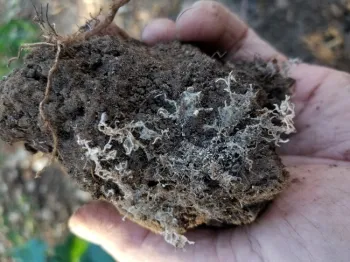There's a Fungus Among Us!
MYCORRHIZA:
noun (mycorrhizae – plural). Pronunciation: my-core-RYE-zah , singular / my-core-RYE-zee, plural

In simplistic terms, this relationship is the food and water transportation system for plants. The science of the subject is quite complex leaving the reader struggling to pronounce words with six or more syllables and memorizing the differentiation between types and subtypes and sub-subtypes. There are two primary subtypes: Arbuscular Mycorrhiza (AMF) and Ectomycorrhiza (EMF).
AMF is the most common, colonizing the roots of the plant and spreading broadly into the soil in search of water and minerals. This type of fungal network and plant partnership is found in 85% of all plants from crops to forests. EMF provides the same symbiotic health benefits to 10% of the world's plants. This relationship is common with conifers and some deciduous trees. The fungal networks attach to the root's surface and spread from there. Scientists have found that this type of mycorrihzal relationship is frequently exclusive: certain fungi work with certain species.
For more comprehensive information about this complicated topic these are two excellent references:
Mycorrhizal fungi: all you need to know about the Internet of Plants

